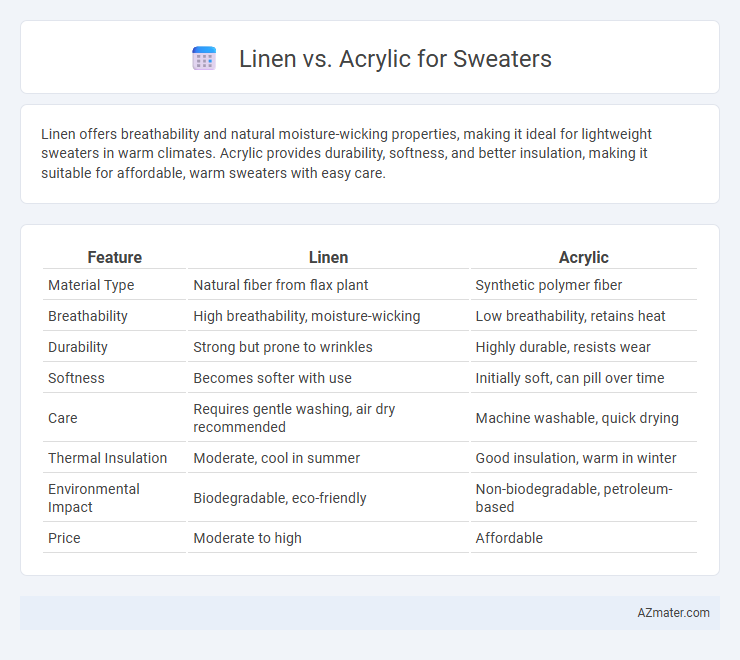Linen offers breathability and natural moisture-wicking properties, making it ideal for lightweight sweaters in warm climates. Acrylic provides durability, softness, and better insulation, making it suitable for affordable, warm sweaters with easy care.
Table of Comparison
| Feature | Linen | Acrylic |
|---|---|---|
| Material Type | Natural fiber from flax plant | Synthetic polymer fiber |
| Breathability | High breathability, moisture-wicking | Low breathability, retains heat |
| Durability | Strong but prone to wrinkles | Highly durable, resists wear |
| Softness | Becomes softer with use | Initially soft, can pill over time |
| Care | Requires gentle washing, air dry recommended | Machine washable, quick drying |
| Thermal Insulation | Moderate, cool in summer | Good insulation, warm in winter |
| Environmental Impact | Biodegradable, eco-friendly | Non-biodegradable, petroleum-based |
| Price | Moderate to high | Affordable |
Introduction to Linen and Acrylic Sweaters
Linen sweaters are crafted from natural flax fibers, offering breathability, moisture-wicking properties, and a lightweight texture ideal for warmer climates. Acrylic sweaters, made from synthetic polymer fibers, provide durability, softness, and excellent insulation suitable for colder conditions. Each material caters to different needs, with linen emphasizing comfort and breathability while acrylic focuses on warmth and resilience.
Material Composition: Linen vs Acrylic
Linen sweaters are made from natural fibers derived from flax plants, offering breathability, moisture-wicking properties, and a lightweight feel ideal for warm weather. Acrylic sweaters consist of synthetic fibers made from polymer compounds, providing durability, wrinkle resistance, and vibrant color retention but often lacking the breathability of natural materials. The choice between linen and acrylic depends on preferences for natural comfort versus synthetic resilience and ease of care.
Comfort and Feel: Which Is Softer?
Linen sweaters offer a cool, breathable softness ideal for warm weather, providing a natural texture that feels light and airy against the skin. Acrylic sweaters, known for their plush and smooth finish, deliver a cozy, wool-like softness that retains warmth and resists moisture. Between the two, acrylic is generally softer to the touch, while linen excels in breathability and a fresh, crisp feel.
Breathability and Temperature Regulation
Linen sweaters offer superior breathability due to their natural fibers, allowing air to circulate freely and keeping the body cool in warm weather. Acrylic sweaters, while lightweight, tend to trap heat and moisture, making them less effective for temperature regulation. Choosing linen enhances comfort in hot climates by promoting moisture-wicking and rapid drying, whereas acrylic is better suited for cooler conditions where insulation is desired.
Durability and Longevity Comparison
Linen sweaters offer exceptional durability due to their natural fiber strength and resistance to wear, making them ideal for long-term use. Acrylic sweaters, while softer and more lightweight, tend to pill and lose shape faster under frequent washing and abrasion. Investing in linen results in a longer-lasting garment that maintains its structure better than acrylic alternatives over time.
Care and Maintenance Requirements
Linen sweaters require gentle hand washing or machine washing on a delicate cycle with cold water, avoiding bleach to maintain fiber integrity and prevent shrinking. Acrylic sweaters are more durable and can often withstand machine washing in warm water with mild detergent, retaining shape and color with less risk of damage. Proper drying methods differ as linen should be air-dried flat to avoid distortion, while acrylic can withstand low-heat tumble drying but benefits from air drying to extend the garment's lifespan.
Style and Appearance Differences
Linen sweaters offer a natural, breathable texture with a subtle sheen that enhances a casual yet sophisticated look, ideal for warm-weather layering. Acrylic sweaters, on the other hand, provide a smooth, uniform appearance with vibrant color retention and a slightly glossy finish, making them versatile for both casual and dressier styles. The distinct visual textures--linen's slight irregularity versus acrylic's consistent smoothness--significantly influence the overall aesthetic and garment drape.
Environmental Impact and Sustainability
Linen sweaters have a significantly lower environmental impact compared to acrylic due to linen's biodegradability and cultivation from flax plants, which require fewer pesticides and less water than synthetic fiber production. Acrylic fibers are petroleum-based, non-biodegradable, and energy-intensive to produce, contributing to microplastic pollution in oceans during washing. Choosing linen supports sustainable agriculture and reduces long-term pollution, making it a more eco-friendly option for sweater materials.
Cost and Affordability Factors
Linen sweaters typically cost more than acrylic due to the natural fiber's durability and breathability, making them a longer-term investment. Acrylic sweaters provide a budget-friendly alternative, often priced significantly lower while offering ease of care and resistance to wrinkles. Consumers seeking affordability often prefer acrylic for its low initial cost, whereas linen appeals to those prioritizing quality despite a higher price.
Choosing the Right Sweater: Linen or Acrylic?
Linen sweaters offer breathability, moisture-wicking properties, and natural durability ideal for warmer climates or layering in mild weather. Acrylic sweaters provide excellent insulation, softness, and easy care, making them suitable for colder temperatures and hypoallergenic preferences. Selecting between linen and acrylic depends on desired warmth, fabric feel, and maintenance needs for optimal comfort and style.

Infographic: Linen vs Acrylic for Sweater
 azmater.com
azmater.com